Martial Arts
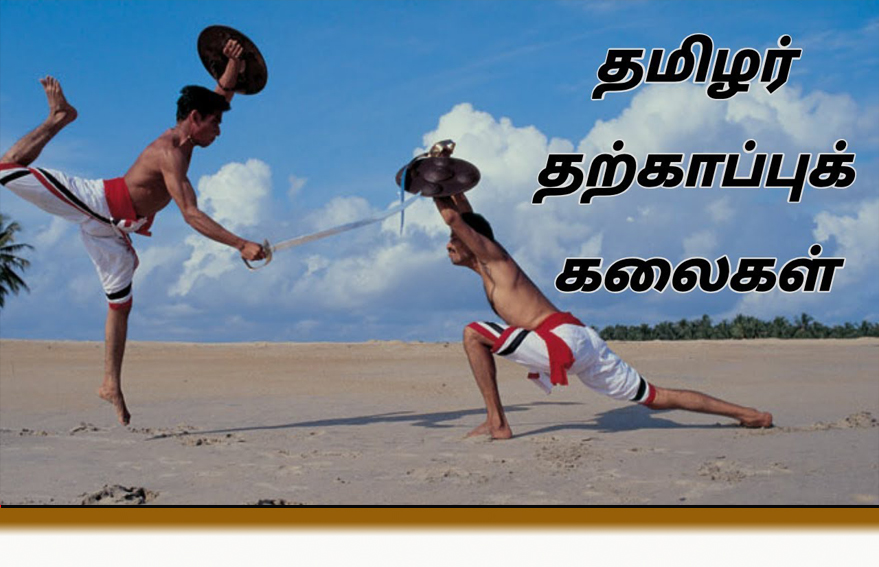
Various martial arts including Adimurai, Kuttu Varisai, Varma Kalai, Silambam, Adithada, Malyutham and Kalarippayattu, are practised in Tamil Nadu and Kerala. The warm-up phase includes yoga, meditation and breathing exercises. Silambam originated in ancient Tamilakam and was patronized by the Pandyans, Cholas and Cheras, who ruled over this region. Silapathigaram, a Tamil literature from the 2nd century AD, refers to the sale of Silamabam instructions, weapons and equipment to foreign traders. Since the early Sangam age, there was a warlike culture in South India.
War was regarded as an honorable sacrifice and fallen heroes and kings were worshiped in the form of a Hero stone. Each warrior was trained in martial arts, horse riding and specialized in two of the weapons of that period Vel spear Val sword and Vil bow. Heroic martyrdom was glorified in ancient Tamil literature. The Tamil kings and warriors followed an honour code like that of Japanese Samurais and committed suicide to save the honor.
The forms of martial suicide were known as Avipalli, Thannai, Verttal, Marakkanchi, Vatakkiruttal and Punkilithu Mudiyum Maram. Avipalli was mentioned in all the works except Veera Soliyam. It was a self-sacrifice of a warrior to the goddess of war for the victory of his commander. The Tamil fighters in North-east region of Sri Lanka reflected some elements of Tamil martial traditions which included worship of fallen heroes Maaveerar Naal and practice of martial suicide. They carried a Suicide pill around their neck to escape the captivity and torture. A remarkable feature besides to their willingness to sacrifice is, that they were well organized and disciplined. It was forbidden for the rebels to consume tobaccos, alcohols, drugs and to have sexual relationship.
Traditional Weapons
The Tamil martial arts also include various types of weapons.
- Kathi – dagger/knife
- Reddai Vaal – dual sword
- Silambam – long bamboo pole
- eetti or Vel – spear
- Vil – bow
- Savuku – whip
- Soolam – trident
- Kattari – fist blade
- Maduvu – deer horns
- Tantayutam – mace
- Valari throwing – iron sickle
- Theekutchi – flaming baton
- Yeratthai Mulangkol – dual stick
- Vaal + Ketayam – sword + shield
- Kuttu Katai – spiked knuckleduster
- Veecharuval – battle Machete
- Surul Vaal – curling blade
Silambam
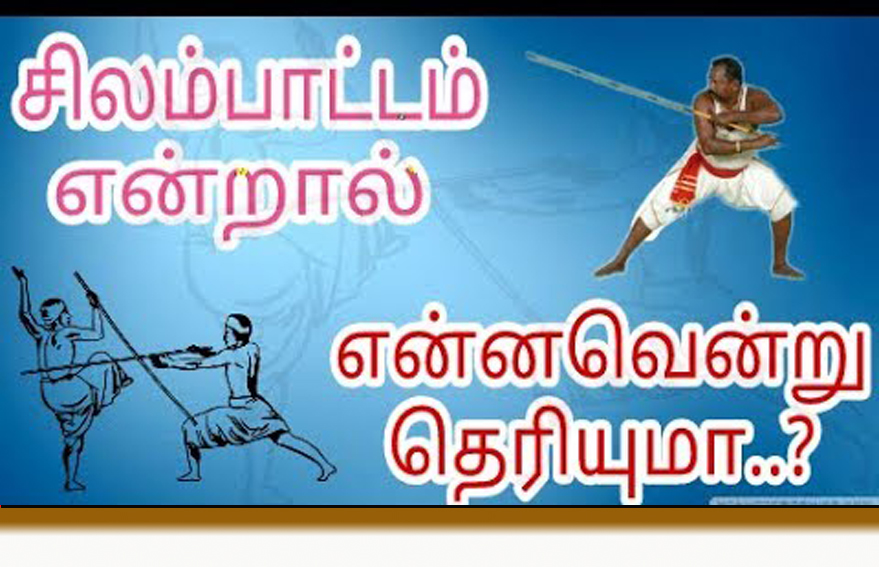
Silambam, Origins
Oral folklore traces Silambam back several thousand years to the siddhar enlightened Agatya munivar. While on his way to Vellimalai, Agastya discussed Hindu philosophy with an old man he met, said to be the god Murugan in disguise. The old man taught him of kundalini yoga and how to focus prana through the bodys nadi channels. Agastya practiced this method of meditation and eventually compiled three texts on palm leaves based on the gods teachings. One of these texts was the Kampu Sutra which was said to record advanced fighting theories in verse. These poems and the art they described were allegedly passed on to other Siddha of the Agastmuni akhara Agastya school and eventually formed the basis of Silambam, siddha medicine, and also influenced the southern style of kalaripayattu.
References in the Silappadikkaram and other works of Sangam literature shows that silambam has been practiced as far back as the 4th century BC. The bamboo sticks – along with swords, pearls and armor – was in great demand with foreign traders, particularly those from Southeast Asia where silambam greatly influenced many fighting systems. The Indian community of the Malay Peninsula is known to have practiced silambam as far back as the period of Melakas sounding in the 15th century, and likely much earlier.
The soldiers of Kings Puli Thevar, Dheeran Chinnamalai had Silambam army named “thadii pattalam”, Veerapandiya Kattabomman and Maruthu Pandiyar 1760–1799 relied mainly on their Silambam prowess in their warfare against the British Army. Indian martial arts suffered a decline after the British colonists banned Silambam along with various other systems. They also introduced modern western military training which favoured fire-arms over traditional weaponry. During this time, Silambam became more common in Southeast Asia than its native India where it was banned by the British rulers. The ban was lifted after India achieved independence. Today, Silambam is the most famous and widely practiced Indian martial art in Malaysia where demonstrations are held for cultural shows.
- Weapons
Silambams focus is on the bamboo staff. The length of the staff depends on the height of the practitioner. Ideally, it should just touch the forehead about three fingers from the head, typically measuring around 1.68 metres five and a half feet. Different lengths may be used depending on the situation. For instance, the sedikuchi or 3-foot stick can be easily concealed. Separate practice is needed for staffs of different lengths. Listed below are some of the weapons used in Silambam.
- Katti: knife
- Savuku: whip
- Silambam: staff, preferably made from bamboo, but sometimes also from teak or Indian rose chestnut wood. The staff is immersed in water and strengthened by beating it on the surface of still or running water. It is often tipped with metal rings to prevent the ends from being damaged.
- Panthukol: staff with balls of fire or weighted chains on each end
- Kattari: native push-dagger with a H-shaped handle. Some are capable of piercing armor. The blade may be straight or wavy.
- Kuttu katai: spiked knuckleduster
- Surul kaththi: flexible sword
- Aruval: sickle, often paired
- Maru: a thrusting weapon made from deer horns
- Vaal: sword, generally curved
- Sedikuchi: cudgel or short stick, often wielded as a pair.
- Training
The first stages of Silambam practice are meant to provide a foundation for fighting and to condition the body for the training itself. This includes improving flexibility, agility, hand-eye coordination, kinesthetic awareness, balance, strength, speed, muscular endurance, and cardiovascular stamina.
Beginners are first taught footwork kaaladi which they must master before learning spinning techniques and patterns, and methods to change the spins without stopping the motion of the stick. There are sixteen of them among which four are very important. Footwork patterns are the key aspects of Silambam. Traditionally, the masters first teach kaaladi for a long time before proceeding to unarmed combat. Training empty-handed allows the practitioner to get a feel of Silambam stick movements using their bare hands, that is, fighters have a preliminary training with bare hands before going to the stick.
Gradually, fighters study footwork to move precisely in conjunction with the stick movements. In Silambam, kaaladi is the key to deriving power for attacks. It teaches how to advance and retreat, to get within range of the opponent without lowering ones defence, aids in hitting and blocking, and it strengthens the body immensely enabling the fighter to receive non-lethal blows and still continue the battle. The whole body is used to create power.
In the main stance, the staff is held at one end, right hand close to the back, left hand about 40 centimetres 16 inches away. This position allows a wide array of stick and body movements, including complex attacks and blocks. When the student reaches the final stage, the staff gets sharpened at one end. In real combat the tips may be poisoned. The ultimate goal of the training is to defend against multiple armed opponents.
Silambam prefers the hammer grip with the main hand facing down behind the weak hand which faces up. The strong hand grips the stick about a distance hands width and thumbs length from the end of the stick and the weak hand is a thumbs length away from the strong hand.
The weak hand only touches the stick and to guide its movement. Silambam stresses ambidexterity and besides the preferred hammer grip there are other ways of gripping the staff. Because of the way the stick is held and its relatively thin diameter, blows to the groin are very frequent and difficult to block. Besides the hammer grip, Silambam uses the poker grip and ice pick grip as well. Some blocks and hits are performed using the poker grip. The ice pick grip is used in single hand attacks. The staff is held like a walking stick and just hand gets inverted using the wrist.
In battle, a fighter holds the stick in front of their body stretching the arms three-quarters full. From there, they can initiate all attacks with only a movement of the wrist. In fact, most Silambam moves are derived from wrist movement, making it a key component of the art. The blow gets speed from the wrist and power from the body through kaaladi. Since the stick is held in front, strikes are telegraphic, that is, the fighter does not hide their intentions from the opponent. They attack with sheer speed, overwhelming the adversary with a continuous non-stop rain of blows. In Silambam, one blow leads to
and aids another. Bluffs may also be used by disguising one attack as another.
In addition to the strikes, Silambam also has a variety of locks called poottu. A fighter must always be careful while wielding the stick or they will be grappled and lose the fight. Locks can be used to disable the enemy or simply capture their weapon. Techniques called thirappu are used to counter the locks but these must be executed before being caught in a lock. Silambam also has many different types of avoiding an attack like blocking, parrying, enduring, rotary parrying, hammering, kolluvuthal attacking and blocking simultaneously and evasive moves such as sitting or kneeling, moving out, jumping high, etc. Against multiple attackers, silambam exponents do not hold out their sticks as they do in single combat. Instead, they assume one of the numerous animal stances which makes it difficult for opponents to predict the next attack.
An expert of Silambam will be familiar with varma adi or marma adi pressure points and know where to strike anywhere in the body to produce fatal or crippling effects by the least use of power. In one-on-one combat an expert would slide the stick to opponents wrist many times during combat. The opponent may not notice this in the heat of battle until they feel a sudden pain in the wrist and throw the stick automatically without knowing what hit them. When two experts match against each other one may challenge the other that he will hit his big toe. Hitting the big toe can produce crippling effects on the fighter, making them abandon the fight. This is called solli adithal which means “challenging and successfully hitting”.
Traditional masters still encourage students to live a “pure” life through daily meditation and abstaining from drinking, smoking, and meat consumption. Students who have completed the training syllabus by learning every form are considered qualified to teach. The time it takes to complete differs from one style to another. For example, the nillaikalakki style requires around seven years of training while other styles may have no articulated syllabus.
4. World Initiatives
Silambam name has made its historical first time appearance in the world eyes as the committee of United Nations Assembly recommends Silambam Asia for United Nations status for representing Asia Continent. Occasion held at the United Nations Headquarters in New York, United States on January 21, 2019 whereby China-Taipei government representatives arised border conflicts in ancient recording pertaining Silambam and requesting organisation of Silambam Asia to resolve prior to internal committee clearance request. On January 30, 2019 concluded substantive work as the Committee recommended Silambam Asia for Special Status in the United Nations.
In Tamil Films
In quite a number of his movies in 1950s and 1960s, M.G.Ramachandran MGR had incorporated silambam fighting scenes, to popularize this ancient martial arts in the 20th century. MGR himself was an exponent on silambam fighting. Some of these movies include Thaikkupin Tharam, Periya Idathu Penn, Mugaraasi and Thanipiravi.
The history of Silambam
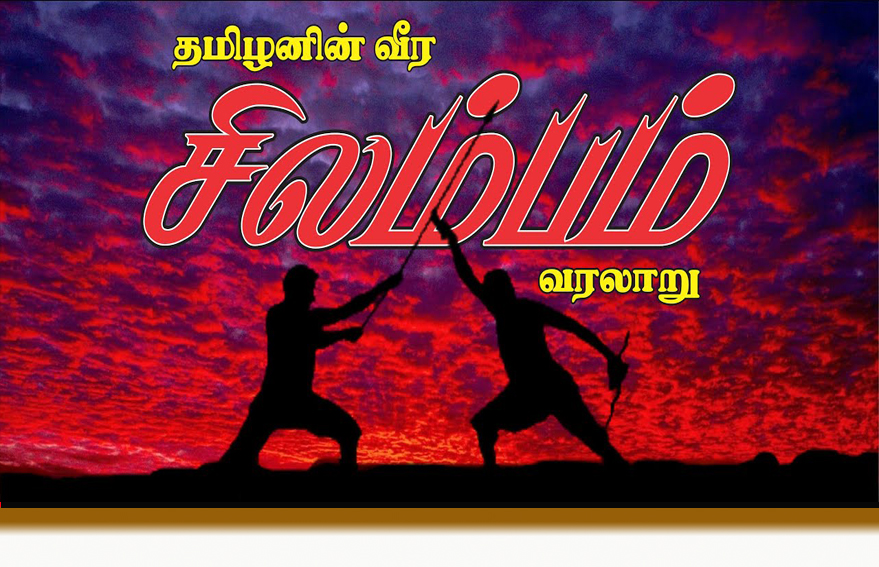
The name Silambam is derived from the word Silambu. Silambu means sounding. It is said that the name Silambam was coined to refer to the general sounds made by the Silambam.
The word “silambam” is derived from the verb “silambal”. Themountains is also known as “Silambam” because of the sound of waterfalls in the mountains, the chirping of birds, the sound of the leaves of the trees moving in the wind,the noise made by all sorts of animals. Hence, the mountain (Kurinji) god Murugan is also known as “Silamban”.
The Tamal Martial art is named as “Silambam” as the sound of the Wooden pole spinning and the sound of the weapons colliding with each other resembles the Kurinji nature.
The mountaineers living in the region near Kadaiyanallur in the Nellai District are also known as “Silambarar”.
Silambam is thought to be about 5000 years old. Agathiya Munivar, who lived 2500 years ago, mentions Silambam as one of the 64 arts.Silambam is mentioned in the Tamil literature “silappathikaaram” that the equipments needed to train for Silambam is sold in a shop and foreigners come buy these with interest.
In thirukkural, the work “Koal”, and in the line from Kalingathuppani “veesu thandidai Koormazhu okkumae” refers to silambam as ‘Koal’ and ‘thandu’. In the book “Badartha Guna Chintamani” written in the 15th century AD, it is said that playing silambam prevents rheumatism, bile and phlegm. Apart from these, there are also manuscripts such as Silambam formula, kurundadi silambam and natasari.
The songs in these inscriptions indicate that Agathiya Munivar studied the arts such as yoga and medicine after studying Silambam. Silambam has weapons such as Suvadu, Pirivuchuvadu, reddai Veechu, Poodupirivu (Lock section),Madu Siramam, ‘edutherithal’, Nedungagampadi’, copatta, sword range, beechua, Surul patta, Lesam, sendaayutham, valari, thunderbolt, dagger, ax, Machete and Vettaruvaal. Oomaithurai has mastered in Surul Patta; kattabomman in Nedungambu; and Sinnamaruthu in Valari.
Valari
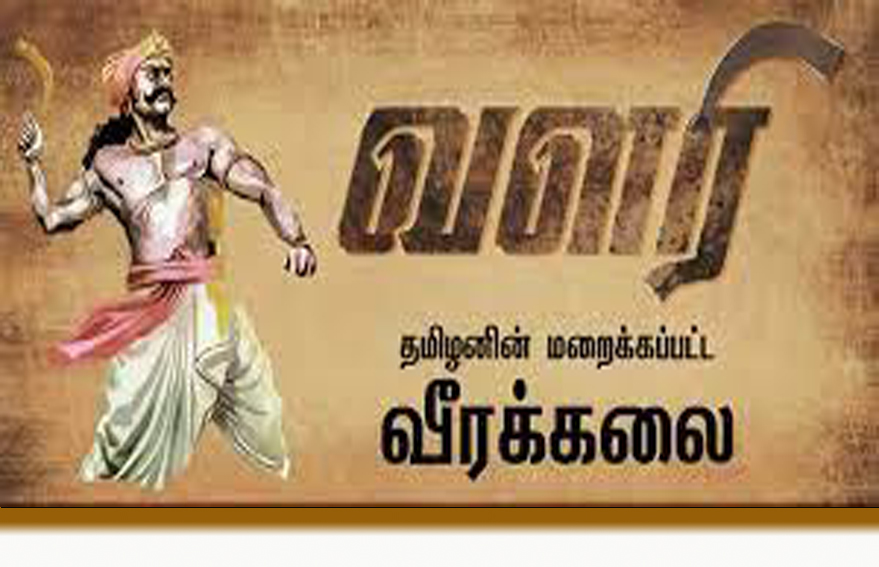
Valari
A valari is a thrown, iron, Returning & non-returning weapon used primarily by the Tamil people of the Indian subcontinent. The valari is used for protecting cattle from predators, and for war and hunting. It was the weapon of choice in deer hunting. It predates the Australian wooden boomerang, and was used widely in India since the Upper Paleolithic, most notably in the Deccan plains by kingdoms for war and most probably by the kings of present-day Madurai, Tirunelveli & Ramanathapuram in Tamil Nadu. The history of the valari is rooted in ancient times and literary evidence can be found in the Tamil Sangam “Purananuru”.
- Construction
Like the hunting boomerang of the aboriginal Australians, some valari also return to the thrower. Returning boomerangs used for sport have special aerodynamics to enable the return but hunting boomerangs are designed to fly straight or slightly curved to hit a target.
Valaris are made in many shapes and sizes. The usual form consists of two limbs set at an angle; one thin and tapering, the other rounded to form a handle. Valaris are usually made of iron cast in moulds, although some may have wooden limbs tipped with iron or have lethally sharpened edges.
- Use
The thrower holds the valari by one of its limbs and throws it. There are several ways of throwing and aiming. It is usually given a spin while throwing. While flying, it can manoeuvre and execute several types of movements according to the throwers purpose. It may spin in the vertical axis, horizontal axis, or just fly without spinning. The spin may also vary in speed. A lethal throw is given a spin and aimed at the neck. A non-lethal throw is given a spin and aimed at the ankles or knees. This is to capture a fleeing victim. A simple hurting blow does not have any spin. It is sharp enough to cut through a person’s neck during war.
It is mostly used once for wars and hunting by the people of Tamil Nadu, known as Kallar and Maravar people. The English destroyed most of the valaris when they came for conquest as they thought it would be a potential weapon of war. Only a handful of valaris are left in Tamil Nadu now.
THE MADUVU, ALSO KNOWN AS A MARU OR MADU
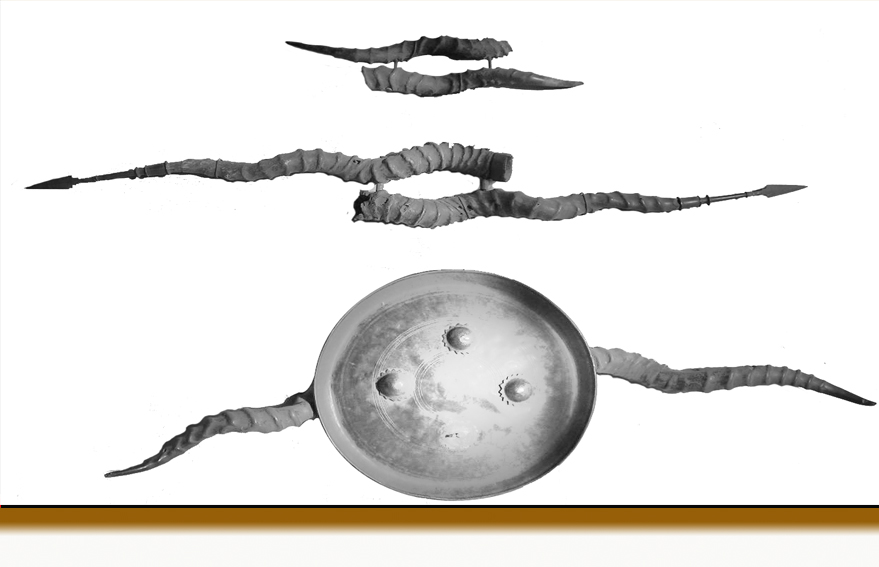
Maduvu
The maduvu, also known as a maru or madu, is a weapon from India. It is one of the many weapons used in Tamil martial arts Silambam.
Most commonly called madu, it is also referred to as maan kombu after the deer horns from which it is made, specifically from Indian Blackbuck Antilope cerviapra, also known as the Indian antelope. It is treated like a double-bladed dagger. The weapon typically consists of two blackbuck horns pointing in opposite directions connected by two crossbars which also act as a handle. Silambam experts use this weapon to confront silambam staff fencing opponents in various methods, for defensive or offensive. The fighting of Maduvu always begins with pay respect refer to Salutation of Silambam. After that, the fight of maduvu will commence. Usually, Silambam fighter will prefer to use Maduvu as defensive rather than offensive, to fight with opponents which using silambam long staff fencing and short staff fencing.
Later variations were often tipped with steel and sometimes fitted with a plate of leather or steel to act as a shield. In Punjab, the maru was typically constructed entirely of steel. A similar weapon, consisting of a handle mounted on an antelope horn, was used as a crutch and served as a self-defense implement for the jogi who were forbidden by their order to carry conventional weaponry.
- Technique
The maru is a primarily defensive weapon favouring a low stance, in which the wielder strives to stay lower than the opponent thereby reducing any openings to the body’s vital points. Typically, the maru-wielder will block or parry attacks before countering with a thrust, choke, lock or disarm. Offensively the maru is treated similarly to a dagger, used for stabbing
- Positioning
The grounding method is the favourite choice of maduvu fighter, whereby maduvu holding person will try to make himself lower than the opponent to reduce the space of attack and to reduce the body from exposure to simultaneous attacks.
- Stances
Various stances and routines based on animal movements such as the frog leap, snake, mouse, tiger, elephant, and eagle forms were used in the battle of Maduvu.
- Foot Work
Similar to footwork used in Silambam and Kalari fighting styles. Kaladi Varisai is performed with house building method which much described in Silambam footwork.
- Maduvu Sala-Varisai
Various Pattern or Kata of Deer Horn was evolved with different styles in a different state in India. Original Maan Kombu or Maduvu Sala-Varisai is also known as the advance form of pattern in Indian martial arts, which mostly practiced by black belt experts. The beginning of this lesson will take place upon graduation which followed by traditional rituals in the temple known as “Arrangetram”. After this graduation ceremony, the Instructor Guru / Aasan will then teach his student as further studies in the Advance form of Silambam Martial Arts.
- Fighting Skills
Usually, maduvu fighter will use this weapon in a close combat situation, whereby his opponent attacks by using a long blade knife or sword, silambam long staff fencing and sedi kuchi or muchchaan short staff fencing. Performing this maduvu skills in front live audience usually will start with maduvu fighter receive simultaneous attacks this is to show his skills of close combat bravery, accuracy of defensive skills and agility to evade the attacks and finally end the fight with choke, lock or disarm the opponent or his weapon with sudden strikes at proximity of offensive range. Usually, maduvu fighter needs to have great accuracy, good timing sense and cautious upon ending his final move to prevent his opponent from evading.